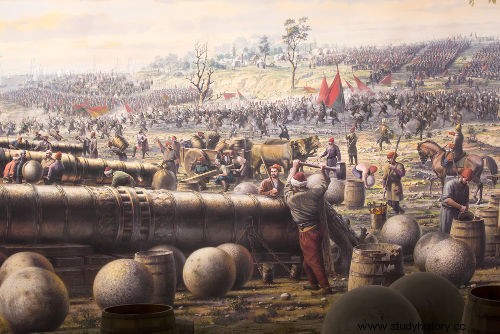
By Me. Cláudio Fernandes
The fall of Constantinople it is a fact of extreme importance in historical terms. In order to have a dimension of this importance, it is enough to think that the day it occurred, May 29, 1453 , was long (and still is, in some cases) considered to mark the end of the Middle Ages and beginning of the Modern Age . The fall of Constantinople was the symbol of the decline of the Eastern Roman Empire (also known as Byzantine Empire ), inaugurated by Constantino – which had given its name to the city – in the 4th century AD. This same event also marked the triumph of another empire, the Ottoman , which formed from a Turkish sultanate in 1299 and was responsible for the conquest of Constantinople.
The Eastern Roman Empire represented, in the Middle Ages, what was still the most powerful, in institutional terms, inherited from the ancient Roman Empire. Because it is located in a strategic place in Anatolia (Asia Minor), Constantinople has always been a city coveted by various civilizations. Many tried to subdue her, from barbarians, Huns e even the crusader knights Christians.
The frequent attacks ended up leaving the city's defenses in poor condition, and its territory drastically reduced. Although during the 14th century they had negotiated several times with the Byzantines, at the time of Emperor John V Palaiologos , the Ottomans, who fought for space in Anatolia, under the command of the sultan Mehmed II , dealt the fatal blow to the city. Famous for its wall that had protected it for centuries, Constantinople was not able to resist the power of the Ottoman cannons. With the battle won, Mehmed II soon set out to establish symbolic links with the city. The main Christian landmark of Constantinople, the basilica of Hagia Sofia (Holy Wisdom), was transformed into a mosque on the same day that the Ottomans managed to break through the walls, as historian Alan Palmer recounts:
When Sultan Mehmed II entered Constantinople in his gray that Tuesday afternoon, he went first to Hagia Sophia, the church of St. Wisdom, and took the basilica under his protection before ordering it to be turned into a mosque. About sixty-five hours later, he returned to the basilica for the Friday noon prayers. The transformation was symbolic to the Conqueror's plans. The same happened when he insisted on solemnly investing a learned orthodox monk on the then vacant patriarchal throne. [1]
A while later the city of Constantinople would receive the name of Istanbul (name meaning "in the city") and would become the seat of the Ottoman Empire. This Empire survived until the beginning of the 20th century, when the World War I took place. (1914-1918), which caused the breakup of its unit.
* Image credit: Shutterstock and lester120
NOTES
[1] PALMER, Alan. Decline and Fall of the Ottoman Empire . trans. Cleuber Vieira. São Paulo:Globo, 2013. pp. 1-2.
